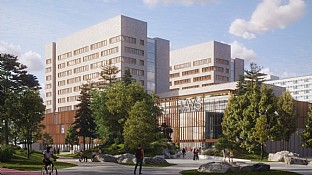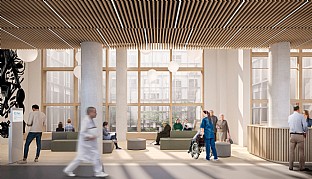The project is a part of an urban development plan for the local university, somatic hospital, and psychiatry. The expansion contains emergency, operation and ICU, and general outpatient clinics and wards for different specialties. Further, a new overall structure improves wayfinding and links the exicting volumnes with the new ones via a loop main flow.
Efficient and Healing Architecture
Besides efficiency, in terms of a modular and standardized building structure that is adaptable for future changes and improves workflow, a great focus in the design has been healing architecture supporting an un-stressful work environment and recovery of patients. This is reflected by the composition of the volume which creates optimal daylight conditions in the whole building, and great views from the wards placed on top. Further, the design supports intuitive and inviting wayfinding with separated flows for discretion and efficiency, spatial hierarchy, and warm materials that gives an atmosphere of home and privacy.
Welcoming Atmosphere
The new hospital volume relates to the scale on site and existing buildings. To avoid the expansion appears massive it is divided into smaller volumes with height variation. This composition creates a welcoming atmosphere for both patients, relatives, and staff.
On the façade, the materials indicate the divisions of the building. The treatment base has a tactile and warm grid façade structure and open glass facades along the main flow and waiting areas. Whereas the wards have white vertical gables relating to the existing ward building.
The project is developed by integrating user involvement and international best practice for an innovative and efficient structure.






